Area Between Curves: y = cos(pi*x), y = 4x^2 -1
TLDRThe video offers a clear example of calculating the area between two curves, specifically y=cosine(πx) and y=4x^2-1. The presenter begins by graphing both functions, noting the period of the cosine function and identifying the intersection points at x=-1/2 and x=1/2. The integral to find the area is set from -1/2 to 1/2, subtracting the polynomial from the trigonometric function. The antiderivative of the cosine function is found using the chain rule, resulting in (1/π)sine(πx), while the polynomial's antiderivative is 4/3x^3 - x. After evaluating the integral at the bounds, the area is simplified to 2/π + 2/3. The presenter then reflects on the process, suggesting improvements such as distributing the negative sign for clarity and recognizing the even function property to simplify the integral to twice the integral from 0 to 1/2, which would have made the calculation more straightforward. The video concludes with an apology for the mental arithmetic challenges faced but assures that the problem was successfully solved, wishing viewers good luck in their own mathematical endeavors.
Takeaways
- 📈 The video provides a straightforward example of finding the area between two curves: y = cosine(πx) and y = 4x² - 1.
- 📊 It is often challenging to find the area between a trigonometric function and a polynomial due to complex intersection points.
- 🎨 The presenter suggests graphing the region first to visualize the area of interest, which includes plotting both cosine and polynomial functions.
- 🔍 The cosine function has a period of 2, so the graph is drawn from -2 to 2 on the x-axis to cover one full period.
- 🔢 Intersection points of the curves are calculated by solving the equation 4x² - 1 = 0, which are found to be at x = -1/2 and x = 1/2.
- ∫ The integral to find the area is set up from -1/2 to 1/2, with the top curve minus the bottom curve, followed by dx.
- 🔑 The antiderivative of cosine(πx) is found using the chain rule, resulting in (1/π)sine(πx).
- 🧮 The antiderivative of 4x² is calculated as (4/3)x³, and the antiderivative of the constant -1 is x.
- 📐 The final integral is evaluated by substituting the upper and lower bounds into the antiderivative expression.
- 🤔 The presenter acknowledges potential improvements in the process, such as distributing the negative sign and recognizing the even function property.
- 💡 An even function could simplify the problem by rewriting the integral as 2 times the integral from 0 to 1/2, which is a key insight for solving similar problems.
- 📝 The final area of the region bounded by the curves is calculated to be (2/π) + (2/3), after simplifying the evaluated integral.
Q & A
What is the main topic of the video?
-The main topic of the video is finding the area between the curves y = cosine of PI x and y = 4x squared minus 1.
Why is it often challenging to find the area between a trigonometric function and a polynomial?
-It is challenging because the intersection points between a trigonometric function and a polynomial are usually messy and often require the use of a calculator to find their exact values.
What is the period of the cosine function?
-The period of the cosine function is 2π, but in this context, the period is given by 2π divided by PI, which simplifies to 2.
What are the x-values for the intersection points of the given curves?
-The x-values for the intersection points of the curves are -1/2 and 1/2.
What is the antiderivative of cosine of PI x?
-The antiderivative of cosine of PI x is 1/PI times sine of PI x, by applying the chain rule.
What is the antiderivative of 4x squared?
-The antiderivative of 4x squared is 4/3 x cubed.
How is the final integral set up to find the area between the curves?
-The final integral is set up as the integral from -1/2 to 1/2 of (cosine of PI x - (4x squared - 1)) dx.
What is the final result of the area between the curves?
-The final result of the area between the curves is 2/PI + 2/3.
What is an improvement that could have been made during the integration process?
-An improvement would have been to distribute the negative sign across the terms in the integral, which would have simplified the expression.
Why is it beneficial to recognize that the function is even?
-Recognizing that the function is even allows you to rewrite the integral as twice the integral from 0 to 1/2 of the function, simplifying the problem since you're only solving for half the region and then doubling the result.
What is the significance of graphing the region before integrating?
-Graphing the region helps visualize the area you are trying to calculate and ensures you understand the limits of integration and the shape of the region, which can be particularly helpful when dealing with complex functions.
What is a common mistake made during the problem-solving process in the video?
-A common mistake made in the video is not initially distributing the negative sign across the terms of the polynomial, which could have simplified the integration process.
Outlines
📈 Calculating Area Between Curves: Cosine vs Polynomial
The video begins with an introduction to finding the area between two curves: y = cosine(πx) and y = 4x^2 - 1. The presenter acknowledges the usual complexity when dealing with trigonometric and polynomial functions due to messy intersection points, but notes this example will be more straightforward. The process starts with graphing the curves to visualize the region of interest, which is bounded by the x-axis and the two curves intersecting at x = -1/2 and x = 1/2. The integral to calculate the area is set up as the integral from -1/2 to 1/2 of the top curve minus the bottom curve, which simplifies to (cosine(πx) - (4x^2 - 1))dx. The antiderivative of each function is found, and the bounds are substituted to compute the area. The presenter also discusses potential improvements in the calculation process, such as distributing the negative sign and recognizing the even function property to simplify the integral.
🤓 Reflecting on the Calculation and Simplification Strategies
The second paragraph focuses on reflecting the calculation process and suggesting improvements. The presenter points out that distributing the negative sign across the polynomial would have simplified the integral setup. More importantly, the video highlights that the function (cosine(πx) - 4x^2 + 1) is an even function. This realization could have significantly simplified the problem by allowing the integral to be rewritten as twice the integral from 0 to 1/2, which would have been easier to solve. The presenter emphasizes the importance of recognizing these properties and the usefulness of having a graph to visualize the evenness of the function. The video concludes with an apology for any mental arithmetic errors and a hopeful note that the viewers found the content helpful.
Mindmap
Keywords
💡Area between curves
💡Cosine function
💡Polynomial
💡Intersection points
💡Integration
💡Antiderivatives
💡Even function
💡Graphing
💡Period
💡Substitution
💡Chain rule
💡Mental arithmetic
Highlights
The video demonstrates finding the area between the curves y = cosine(PI*x) and y = 4x^2 - 1.
The intersection points of the curves are at x = -1/2 and x = 1/2, which define the bounds for the integral.
The cosine function has a period of 2, which is used to determine the x-axis limits for graphing.
The polynomial y = 4x^2 - 1 has a y-intercept at -1 and x-intercepts at x = ±1/2.
The integral to find the area is set up from -1/2 to 1/2 of the top curve minus the bottom curve.
The antiderivative of cosine(PI*x) is found using the chain rule, resulting in (1/PI) * sine(PI*x).
The antiderivative of 4x^2 is calculated as (4/3) * x^3, and the antiderivative of the constant 1 is x.
The final integral is evaluated by substituting the upper and lower bounds, simplifying to (2/PI) + (2/3).
The video suggests that distributing the negative sign earlier could have simplified the integral setup.
An even function is identified in the integral, which could have been used to simplify the calculation by integrating from 0 to 1/2 and then doubling the result.
The video emphasizes the importance of graphing the region to understand the problem and identify potential simplifications.
The cosine graph is plotted starting at its maximum value, showing the periodic nature of the function.
The polynomial graph is plotted with its y-intercept and x-intercepts, which coincide with the cosine function's intercepts.
The video provides a walkthrough of the integration process, including the setup and evaluation of the integral.
The final area of the region bounded by the curves is expressed as a sum of two terms, (2/PI) and (2/3).
The presenter apologizes for the complexity of the mental arithmetic and encourages viewers to follow along with the problem-solving process.
The video concludes by wishing viewers good luck and hoping they found the content helpful.
Transcripts
Browse More Related Video
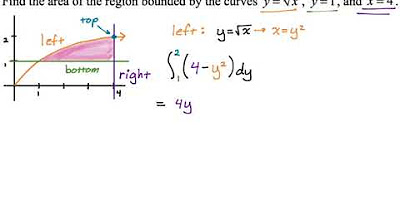
Area Between Curves: Integrating with Respect to y (Example 3)
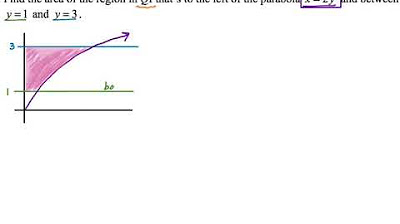
Area Between Curves: Integrating with Respect to y (Example 1)
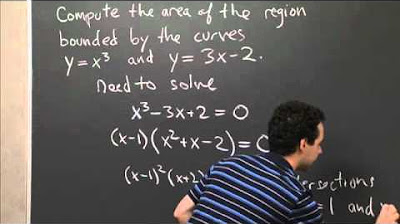
Area Between y=x^3 and y=3x-2 | MIT 18.01SC Single Variable Calculus, Fall 2010
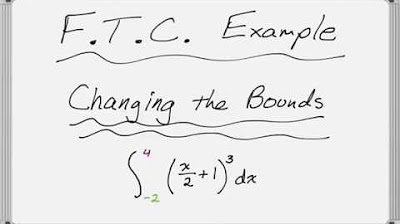
Fundamental Theorem of Calculus: Changing the Bounds with u-Substitution
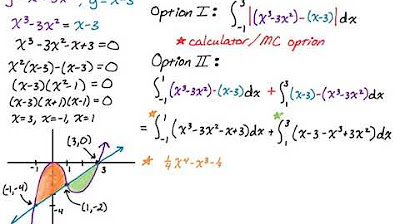
Area Between Two Curves with Multiple Regions: y = x^3-3x^2 and y = x-3

Lagrange Multiplier Example
5.0 / 5 (0 votes)
Thanks for rating: